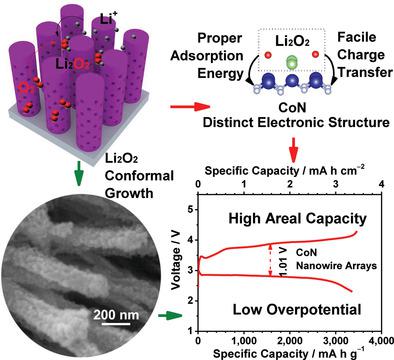当前位置:
X-MOL 学术
›
Small Methods
›
论文详情
Our official English website, www.x-mol.net, welcomes your feedback! (Note: you will need to create a separate account there.)
Combinational Design of Electronic Structure and Nanoarray Architecture Achieves a Low‐Overpotential Oxygen Electrode for Aprotic Lithium–Oxygen Batteries
Small Methods ( IF 12.4 ) Pub Date : 2019-12-23 , DOI: 10.1002/smtd.201900619 Liang Xiao 1 , Jingyu Yi 1 , Zongkui Kou 2 , Erwei Li 1 , Bohua Deng 1 , John Wang 2 , Jinping Liu 1, 3
Small Methods ( IF 12.4 ) Pub Date : 2019-12-23 , DOI: 10.1002/smtd.201900619 Liang Xiao 1 , Jingyu Yi 1 , Zongkui Kou 2 , Erwei Li 1 , Bohua Deng 1 , John Wang 2 , Jinping Liu 1, 3
Affiliation

|
Transition metal nitrides (TMNs) are generally recognized as excellent electrocatalysts in aqueous solution because of their distinct electronic structures and high electrical conductivity. However, their potential catalytic activities are rarely studied in the oxygen electrodes of aprotic lithium–oxygen batteries and the intrinsic electroactivities are quite difficult to be manifested in binder‐involved electrodes. Herein, a novel combinational design of electronic structure and nanoarray architecture is proposed to eliminate the influences of binders and additives and achieve high performance of TMNs as oxygen electrodes for aprotic lithium–oxygen batteries. In the case study of CoN nanowire arrays (NAs), experimental coupled with theoretical studies demonstrate that the distinct electronic structure of CoN enables the appropriate adsorption and facile charge transfer between the discharge product Li2O2 and CoN. Results also show that the nanoarray architecture of CoN enables the full utilization of catalytic active sites, efficient mass transportation, and sufficient inner spaces for accommodating the insoluble discharge product. Thus, the CoN NA cathode achieves both a low overall overpotential of 1.01 V and a high areal capacity of 3.35 mA h cm−2. The combinational design principle of electronic structure and electrode architecture provides a promising way to develop advanced oxygen electrode for metal–air batteries.
中文翻译:

电子结构和纳米阵列架构的组合设计实现了用于非质子性锂氧电池的低电位氧电极
过渡金属氮化物(TMNs)由于其独特的电子结构和高电导率,通常被认为是水溶液中的优良电催化剂。然而,在质子惰性锂-氧电池的氧电极中很少研究其潜在的催化活性,并且固有的电活性很难在涉及粘结剂的电极中表现出来。在此,提出了一种新颖的电子结构和纳米阵列结构的组合设计,以消除粘合剂和添加剂的影响,并实现作为非质子锂氧电池氧电极的TMN的高性能。在CoN纳米线阵列(NA)的案例研究中,2 O 2和CoN。结果还表明,CoN的纳米阵列结构能够充分利用催化活性位点,进行有效的质量传输,并具有足够的内部空间来容纳不溶性放电产物。因此,CoN NA阴极既实现了1.01 V的低整体过电势又实现了3.35 mA h cm -2的高面容量。电子结构和电极体系结构的组合设计原理为开发用于金属-空气电池的高级氧电极提供了有希望的方法。
更新日期:2019-12-23
中文翻译:

电子结构和纳米阵列架构的组合设计实现了用于非质子性锂氧电池的低电位氧电极
过渡金属氮化物(TMNs)由于其独特的电子结构和高电导率,通常被认为是水溶液中的优良电催化剂。然而,在质子惰性锂-氧电池的氧电极中很少研究其潜在的催化活性,并且固有的电活性很难在涉及粘结剂的电极中表现出来。在此,提出了一种新颖的电子结构和纳米阵列结构的组合设计,以消除粘合剂和添加剂的影响,并实现作为非质子锂氧电池氧电极的TMN的高性能。在CoN纳米线阵列(NA)的案例研究中,2 O 2和CoN。结果还表明,CoN的纳米阵列结构能够充分利用催化活性位点,进行有效的质量传输,并具有足够的内部空间来容纳不溶性放电产物。因此,CoN NA阴极既实现了1.01 V的低整体过电势又实现了3.35 mA h cm -2的高面容量。电子结构和电极体系结构的组合设计原理为开发用于金属-空气电池的高级氧电极提供了有希望的方法。



























 京公网安备 11010802027423号
京公网安备 11010802027423号